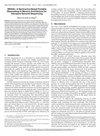SCALES: SCALable and Area-Efficient Systolic Accelerator for Ternary Polynomial Multiplication
IF 1.4
3区 计算机科学
Q4 COMPUTER SCIENCE, HARDWARE & ARCHITECTURE
引用次数: 0
Abstract
Polynomial multiplication is a key component in many post-quantum cryptography and homomorphic encryption schemes. One recurring variation, ternary polynomial multiplication over ring缩放:可伸缩和面积有效的收缩加速器为三元多项式乘法
多项式乘法是许多后量子密码和同态加密方案的关键组成部分。一个反复出现的变化,三元多项式乘法在环$\mathbb {Z}_{q}/(x^{n}+1)$上,其中一个输入多项式具有三元系数{- 1,0,1},另一个具有大整数系数{0,$q-1$},最近引起了各个社区的极大关注。根据这一趋势,本文提出了一种新的可伸缩和面积高效的三元多项式乘法收缩加速器。总的来说,我们进行了三个层次的连贯的相互依赖的努力。首先,我们严格推导了一种新的基于教科书方法的多项式乘法块处理策略和算法。然后,我们借助一些面向现场可编程门阵列(FPGA)的优化技术,创新地实现了所提出的算法作为SCALES加速器。最后,我们进行了全面的实施分析,以展示拟议加速器的效率。对比表明,与最先进的设计相比,SCALES加速器的等效面积时间积(eATP)至少减少19.0%和23.8%。我们希望这项工作能够促进该领域的进一步研究。
本文章由计算机程序翻译,如有差异,请以英文原文为准。
求助全文
约1分钟内获得全文
求助全文
来源期刊

IEEE Computer Architecture Letters
COMPUTER SCIENCE, HARDWARE & ARCHITECTURE-
CiteScore
4.60
自引率
4.30%
发文量
29
期刊介绍:
IEEE Computer Architecture Letters is a rigorously peer-reviewed forum for publishing early, high-impact results in the areas of uni- and multiprocessor computer systems, computer architecture, microarchitecture, workload characterization, performance evaluation and simulation techniques, and power-aware computing. Submissions are welcomed on any topic in computer architecture, especially but not limited to: microprocessor and multiprocessor systems, microarchitecture and ILP processors, workload characterization, performance evaluation and simulation techniques, compiler-hardware and operating system-hardware interactions, interconnect architectures, memory and cache systems, power and thermal issues at the architecture level, I/O architectures and techniques, independent validation of previously published results, analysis of unsuccessful techniques, domain-specific processor architectures (e.g., embedded, graphics, network, etc.), real-time and high-availability architectures, reconfigurable systems.
 求助内容:
求助内容: 应助结果提醒方式:
应助结果提醒方式:


